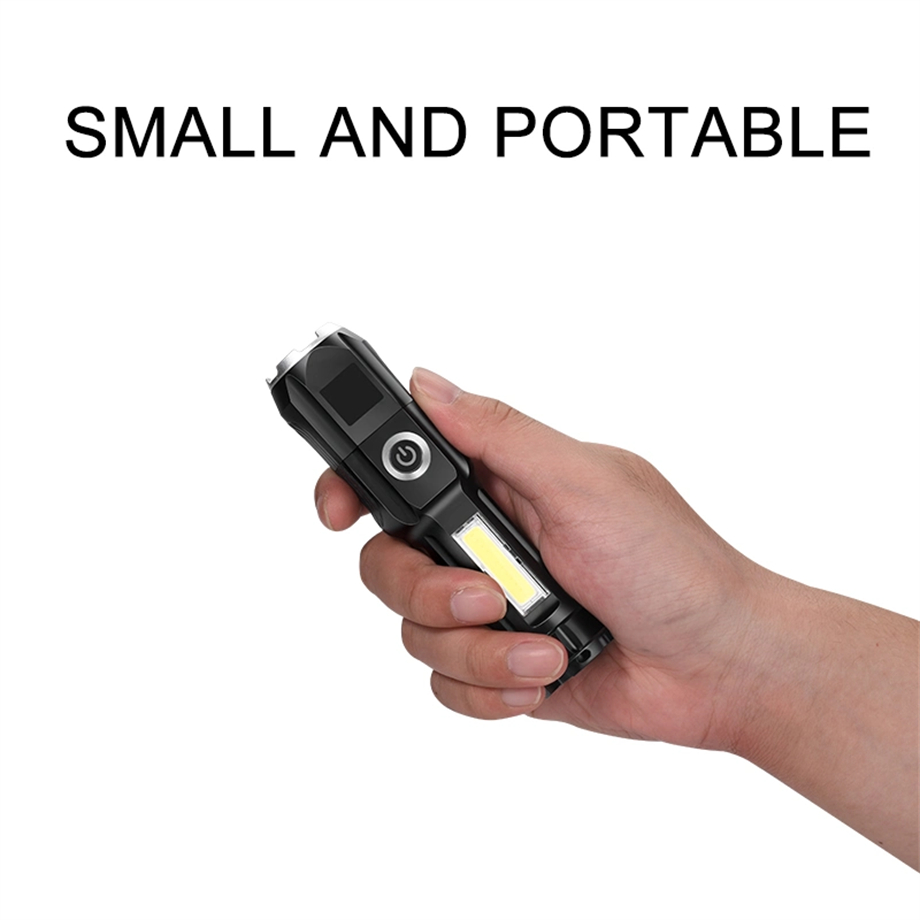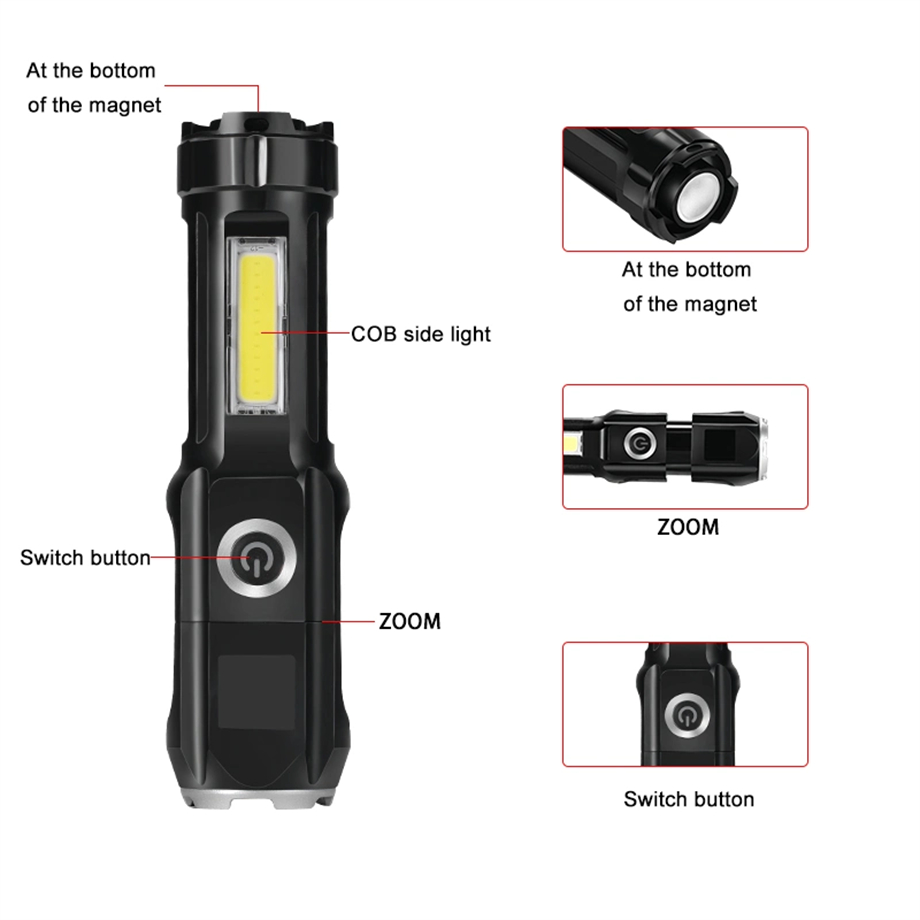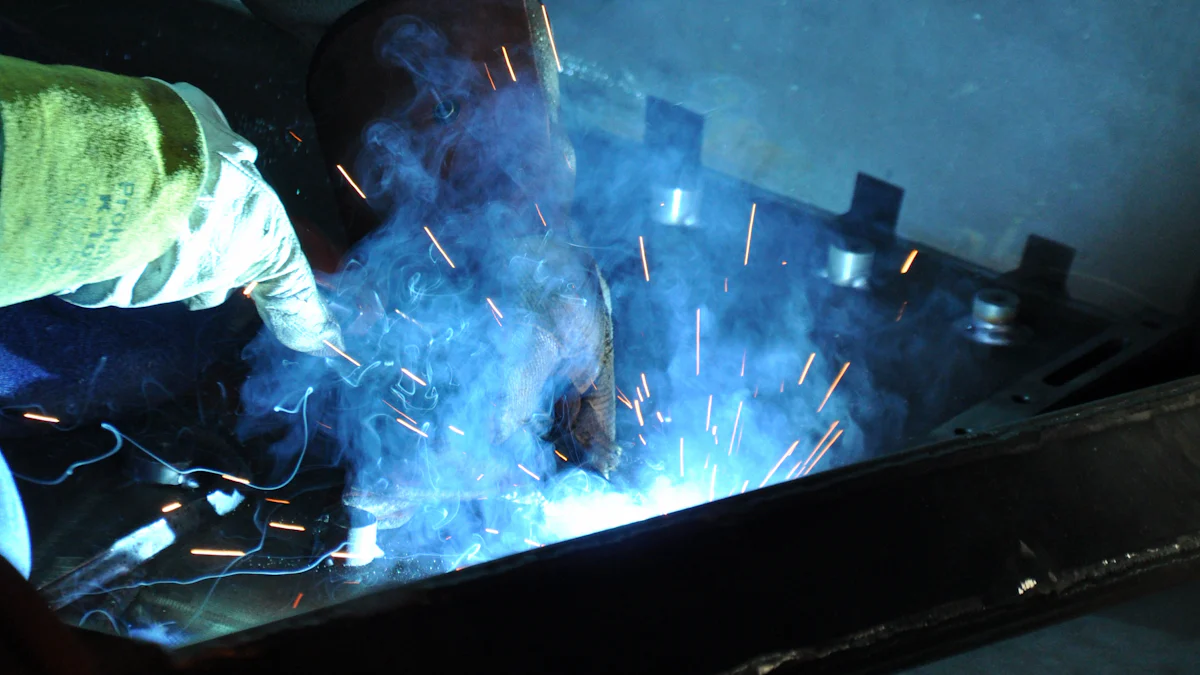Tips for Evaluating Wholesale Flashlight Manufacturers

Sourcing flashlights from reliable suppliers directly affects your business's profitability and customer satisfaction. The right flashlight factory ensures products meet customer needs, such as offering various sizes for convenience or rechargeable options to reduce costs. Features like weatherproofing and durability build customer trust and loyalty. Supplier credibility also plays a vital role in maintaining consistent quality and timely deliveries. Focusing on key factors like product quality, pricing, and logistics helps you make informed decisions. These tips for evaluating wholesale flashlight manufacturers can guide you toward long-term success in the competitive market.
Key Takeaways
Choose manufacturers with certifications like ISO, CE, and RoHS. These ensure the products are safe and high quality.
Check a supplier's reputation by reading reviews and looking for past problems. This helps you find trustworthy partners.
Ask for product samples to test how they work, how bright they are, and how long they last before buying in bulk.
Learn about pricing and ask for discounts when buying more. This saves money and builds good relationships with suppliers.
Keep up with market trends and seasonal needs. This helps you plan inventory and buying strategies better.
Researching Reliable Suppliers
Certifications and Compliance
Industry-standard certifications (e.g., ISO, CE, RoHS)
When evaluating flashlight manufacturers, you should prioritize those with recognized industry certifications. These certifications, such as ISO, CE, and RoHS, indicate that the manufacturer adheres to global quality and safety standards. ISO certification ensures consistent product quality, while CE compliance confirms that products meet European safety requirements. RoHS certification demonstrates a commitment to reducing hazardous substances, which is essential for environmental responsibility. By choosing certified manufacturers, you can ensure your products meet customer expectations and regulatory requirements.
Compliance with safety and environmental regulations
Reliable suppliers must comply with safety and environmental regulations. Manufacturers that follow these regulations produce safer products and reduce environmental impact. For example, compliance with waste management laws ensures proper disposal of materials, while adherence to safety standards minimizes risks to end-users. You should verify these practices to avoid potential legal issues and maintain your business's reputation.
Reputation and Customer Feedback
Online reviews and testimonials
A manufacturer's reputation often reflects its reliability and product quality. You can assess this by reading customer reviews and testimonials. Positive feedback highlights strengths, such as consistent quality or excellent service. Negative reviews, on the other hand, can reveal recurring issues. Look for patterns in customer reviews to identify potential red flags or advantages.
History of disputes or complaints
A supplier's reputation and experience also depend on its ability to resolve disputes. Investigate whether the manufacturer has a history of unresolved complaints or legal issues. Frequent disputes may indicate poor communication or unreliable practices. A clean track record, however, suggests professionalism and trustworthiness.
Communication and Transparency
Responsiveness and clarity in communication
Clear and transparent communication builds trust and improves efficiency. When suppliers respond promptly and provide clear answers, you can address challenges quickly. Open discussions about potential risks allow you to create contingency plans, strengthening your supply chain. Transparent communication also ensures suppliers understand your quality standards, reducing misunderstandings and costly errors.
Benefits of clear communication include:
Better collaboration and problem-solving
Increased efficiency in the supply chain
New opportunities for business growth
Detailed product and company information
Transparency also involves sharing detailed information about products and operations. Manufacturers should provide insights into how their products are made and who oversees production. Social proof, such as customer reviews and testimonials, enhances trust. A strong digital presence and active engagement on social media further demonstrate transparency. These practices help you evaluate the manufacturer's reliability and build a stronger partnership.
Flashlight Sourcing Tips for Evaluating Product Quality

Key Features to Assess
Brightness levels and beam distance
When evaluating a flashlight manufacturer, you should prioritize brightness and beam distance. Brightness, measured in lumens, determines how well the flashlight performs in different scenarios. A higher lumen count ensures better visibility in low-light conditions. Beam distance, on the other hand, indicates how far the light can reach. These features are essential for customers who need flashlights for outdoor activities or professional use.
Durability and resistance to wear and tear
Durability plays a critical role in product quality. Reliable suppliers often use materials like aluminum or steel to ensure their flashlights withstand tough conditions. A durable flashlight resists impacts, water, and extreme temperatures, making it suitable for long-term use. Assessing these qualities helps you select products that meet customer expectations and reduce returns.
Battery life and charging options
Battery life directly impacts usability. Flashlights with longer battery life provide convenience, especially for customers who rely on them for extended periods. Rechargeable options offer additional benefits, such as cost savings and environmental friendliness. You should evaluate these features to ensure the flashlights align with market demands.
Feature | Description |
|---|---|
Brightness | Measured in lumens; essential for performance in various scenarios. |
Durability | Ensures the flashlight can withstand tough conditions; look for materials like aluminum or steel. |
Battery Life | Impacts usability; rechargeable options provide convenience and cost savings. |
Testing and Samples
Performance and reliability of sample products
Requesting product samples is one of the most effective flashlight sourcing tips. Testing samples allows you to evaluate the flashlight's performance and reliability firsthand. You can assess factors like brightness, durability, and battery life to ensure the product meets your quality standards. Sampling also helps you identify potential issues before committing to bulk orders.
"We’ve been offering samples to our customers from day one, and the results have been quite impressive—we’ve seen an uptick in returning clients purchasing full-sized products that they sampled earlier."
Comparison of samples from multiple manufacturers
Comparing samples from different flashlight manufacturers gives you a broader perspective on product quality. This process helps you identify the best options available in the market. It also allows you to negotiate better terms with reliable suppliers by demonstrating your commitment to sourcing high-quality products.
Advantages of requesting samples:
Increases confidence in product quality.
Encourages repeat purchases from satisfied customers.
Warranty and Support
Warranty coverage and terms
A strong warranty reflects the manufacturer's confidence in their product quality. You should review the warranty terms to understand what is covered and for how long. Comprehensive coverage protects your investment and reassures your customers about the product's reliability.
Availability of after-sales support
Customer support and after-sales service are crucial for maintaining customer satisfaction. Reliable suppliers offer prompt assistance with issues like repairs or replacements. This support enhances your reputation and builds trust with your customers. Partnering with a flashlight manufacturer that prioritizes customer support and after-sales service ensures a smoother experience for both you and your clients.
Choosing a Flashlight Factory: Pricing and Order Terms
Pricing Structures
Unit costs and volume-based discounts
Understanding pricing structures is essential when choosing a flashlight factory. Reliable suppliers often offer transparent pricing, which helps you make informed decisions. Evaluate unit costs to ensure they align with your budget and market expectations. Additionally, take advantage of volume discounts. Manufacturers often reduce prices for bulk orders, making it a cost-effective option for businesses.
To negotiate better pricing terms, consider these strategies:
Highlight the benefits of bulk purchases to the supplier.
Time your orders to coincide with seasonal discounts or inventory clearances.
Compare quotes from multiple flashlight factories to secure competitive pricing.
Build long-term relationships with suppliers to foster trust and better terms.
These approaches not only reduce costs but also strengthen your position as a valued customer.
Minimum Order Quantities (MOQs)
Alignment with business needs
Minimum Order Quantities (MOQs) can significantly impact your sourcing strategy. Ensure the MOQ aligns with your business needs and inventory capacity. For smaller businesses, high MOQs may lead to overstocking and increased storage costs. On the other hand, low MOQs provide flexibility, especially when testing new products or entering niche markets.
Negotiating flexible terms
Negotiating MOQs is a critical step in choosing a flashlight factory. Many manufacturers are open to discussions, especially if you demonstrate long-term potential. Highlight your commitment to future orders and explore options for phased deliveries. This flexibility ensures you can manage inventory efficiently while maintaining a strong relationship with the supplier.
Building Long-Term Relationships
Potential for long-term partnerships
Establishing long-term partnerships with flashlight factories offers numerous benefits. Strong relationships foster trust, ensuring suppliers prioritize your orders during disruptions. Open communication also provides access to industry insights, helping you stay ahead of trends. Collaborative partnerships encourage competitive pricing and exclusive terms, such as priority access to new products or flexible payment options.
Loyalty programs or exclusive deals
Many manufacturers offer loyalty programs to reward consistent customers. These programs can include tiered rewards, coalition programs, or premium memberships. For example:
Type | Description | Strengths | Challenges |
|---|---|---|---|
Tiered Loyalty Programs | Rewards based on spending levels. | Focuses on high-value customers, offers better experiences across tiers. | May not appeal to lower-tier customers, can be complex. |
Coalition Loyalty Programs | Operated by multiple businesses, allowing point earning across brands. | Customers earn rewards quickly, expanded customer base for brands. | Data ownership issues, lack of differentiation for individual retailers. |
Premium Loyalty Programs | Fee-based programs offering exclusive benefits. | Provides high-value rewards for top-tier customers. | Requires upfront spending, may not appeal to all customers. |
Premium loyalty programs, in particular, are gaining popularity. These fee-based programs offer exclusive benefits, encouraging repeat purchases and brand loyalty. By leveraging these opportunities, you can strengthen your relationship with the flashlight factory and gain a competitive edge in the market.
Managing Logistics and Shipping

Reliable Shipping Methods
Air, sea, and land shipping options
Choosing the right shipping method ensures your flashlights reach their destination efficiently. Each method offers unique advantages:
Air Shipping: The fastest option, ideal for urgent orders. However, it comes with higher costs.
Sea Shipping: A cost-effective choice for bulk orders. It requires longer transit times but reduces expenses significantly.
Land Shipping: A balanced option for regional deliveries. It combines reasonable costs with moderate delivery speeds.
Selecting the best method depends on your priorities, such as cost, speed, and the need for timely deliveries. For example, air shipping works well for time-sensitive orders, while sea shipping suits large-scale shipments.
Shipping times and costs
Shipping times and costs directly impact your ability to provide timely deliveries. Faster methods like air shipping ensure quick turnaround times but increase expenses. Sea and land shipping reduce costs but require careful planning to avoid delays. Always weigh the trade-offs between speed and cost to maintain both profitability and customer satisfaction.
Import/Export Regulations
Restrictions or tariffs
Understanding import/export regulations prevents unexpected costs or delays. Tariffs and restrictions vary by country, so you must research the destination's requirements. For example, some countries impose higher duties on products with batteries. Staying informed helps you avoid penalties and ensures timely deliveries.
Proper documentation
Proper documentation is essential for smooth customs clearance. Classify your flashlights using the correct Harmonized System (HS) code. Check for required export licenses and prepare shipping documents, such as invoices and packing lists. Compliance with battery transportation regulations ensures safety and avoids delays. Adhering to these practices guarantees your shipments meet quality standards and reach customers on time.
Risk Mitigation
Insuring shipments
Insurance protects your shipments from loss or damage. Follow these steps to ensure adequate coverage:
1. Review the carrier's liability limits.
2. State the value of goods on the Bill of Lading (BOL) and request additional insurance if needed.
3. Consult a third-party logistics provider (3PL) for supplemental insurance options.
4. Document your insurance requests in writing to avoid misunderstandings.
These measures safeguard your investment and ensure timely deliveries, even in unforeseen circumstances.
Trusted freight forwarders
Partnering with trusted freight forwarders minimizes risks. Reliable forwarders handle customs clearance, manage documentation, and plan for potential delays. Their expertise ensures your shipments arrive on time and in excellent condition. This approach enhances your supply chain's efficiency and maintains the quality of your products.
Tip: Combining reliable shipping methods with proper documentation and risk mitigation strategies ensures your flashlights reach customers without delays or damage.
Staying Updated on Market Trends
Industry Innovations
New flashlight technologies
Staying informed about the latest flashlight technologies helps you stay competitive. Manufacturers are introducing innovative features that enhance functionality and user experience. Some of the most exciting advancements include:
Voice-activated flashlights with biometric authentication for added security.
Fast recharge technology, including wireless charging, for convenience.
Dual-functionality flashlights that double as power banks to charge devices.
Bluetooth connectivity and smartphone apps for better control and usability.
Work lights with Bluetooth speakers, combining illumination with audio.
Music sync outdoor lights that adjust brightness to match music rhythms.
Wireless sequence LED warning lights for improved road safety.
These innovations cater to diverse customer needs, from outdoor enthusiasts to professionals. By offering products with these features, you can attract tech-savvy buyers and differentiate your business.
Eco-friendly or smart flashlights
The demand for eco-friendly flashlights continues to grow as sustainability becomes a priority. Rechargeable flashlights, often powered by renewable energy sources, reduce waste and appeal to environmentally conscious customers. Many of these products use eco-friendly materials, further minimizing their environmental impact.
Smart flashlights are also gaining traction. Features like remote control operation and app connectivity enhance convenience. Customizable light settings improve practicality, making these flashlights ideal for various applications. Offering eco-friendly or smart options positions your business as forward-thinking and responsive to market trends.
Seasonal Demands
Peak seasons for flashlight sales
Flashlight sales often peak during specific times of the year. Outdoor activities in summer and fall drive demand for camping and hiking flashlights. Winter months see increased sales due to shorter daylight hours and emergency preparedness needs. Understanding these patterns allows you to plan effectively and maximize profits.
Adjusting inventory and orders
To meet seasonal demands, you should analyze historical sales data and forecast trends. Consider external factors like weather and market conditions to refine your predictions. Use just-in-time inventory principles to optimize stock levels and avoid overstocking. Collaborate with suppliers to align production schedules with demand forecasts.
Tip: Leverage technology for real-time inventory tracking and automation. This ensures you can respond quickly to changes in demand.
Strategic staffing and logistics planning also help manage high order volumes. After the season ends, conduct a thorough analysis to identify areas for improvement. These steps ensure your business remains agile and prepared for future demand cycles.
Evaluating wholesale flashlight manufacturers requires careful attention to several factors. You must assess credibility, product quality, pricing, logistics, and market trends to make informed decisions. Thorough research ensures you choose reliable suppliers who meet your business needs. Strategic decision-making helps you build strong partnerships and stay competitive. Applying these tips for evaluating wholesale flashlight manufacturers will help you source high-quality products and achieve long-term success.
FAQ
What certifications should you prioritize when choosing a flashlight manufacturer?
Focus on certifications like ISO for quality, CE for European safety standards, and RoHS for environmental compliance. These ensure the manufacturer meets global standards and produces reliable, eco-friendly products.
How can you verify a supplier’s reputation?
Check online reviews, testimonials, and industry forums. Look for consistent positive feedback and a clean history without unresolved disputes. This research helps you identify trustworthy manufacturers.
Why is testing product samples important?
Testing samples lets you evaluate performance, durability, and battery life. It ensures the flashlights meet your quality standards before committing to bulk orders, reducing risks.
What factors affect shipping costs and times?
Shipping method, distance, and order size impact costs and delivery times. Air shipping is fast but expensive, while sea shipping is cost-effective for bulk orders. Choose based on your priorities.
How do seasonal trends influence flashlight sourcing?
Seasonal trends affect demand. For example, summer and fall drive sales for outdoor activities, while winter increases demand for emergency lighting. Adjust inventory and orders to match these patterns.
See Also
Essential Guidelines for Finding Trustworthy Flashlight Suppliers
Key Strategies for Selecting the Ideal Flashlight Supplier
Best Practices for Selecting Quality Flashlights in Bulk
Finding the Perfect Flashlights for Your Wholesale Needs
Crucial Advice for Acquiring Wholesale Flashlights for Business
